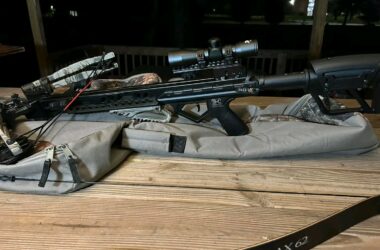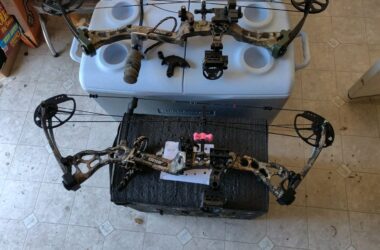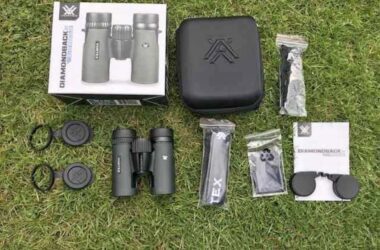A lot of people new to archery think that shooting accurately is easy-peasy. As the truth, not every crossbow can shoot dead center right out at the box (no pun intended). To get pinpoint may require some tuning but within recommended limitations; today, we’re going to learn how to shoot one properly for consistently accurate results from your gear! Before then, let me introduce you to what exactly does it mean when saying “archer” – while many recognize them as someone who used a bow and arrow during medieval times or before now centuries ago. I assure all readers reading these words are modern-day ones, so no worries about being confused).
Read More: Best Bow Stabilizer
A crossbow is a type of bow that shoots horizontally instead of vertically. The draw weights or power behind each arrow shot by this weapon can adjust to suit any shooter’s needs – from children to adults who are more experienced in archery sports like target shooting and hunting with traditional bows. When it comes time for you to try your hand at precision aiming, though, don’t expect an easy game if all goes according to plan! You’ll want some advice on how best to position yourself while also making sure not to exceed tolerances when adjusting tension strings because doing both could cause unwanted movement due to bad shots, but before we get into detail about these points, let me tell you what exactly ‘arcing’ means.
What is Crossbow?
A mechanical bow consisting of moving parts for shooting arrows, the crossbow is much easier to draw than a traditional one. The power and accuracy make it ideal when hunting some larger wildlife creatures like elks in Yellowstone National Park or bears on Kodiak Island off the coast of Alaska – places where you’ll be able to see more members of your family tree!
A simple design with few components makes up this exciting tool: only mechanics which need space as opposed to their predecessor’s manual laboriousness can do so now due at all times being directed upward.
How To Shoot A Crossbow Accurately – Effective Guide
Step 1: Choose The Right Crossbow
The first step in learning how to use a crossbow is choosing the right model. Then, of course, it will depend on your intended purpose for using one and any other factors that may influence his choices, such as age or ability level- this article offers suggestions of some possible models depending upon these two things.
Next, consider if you want to examine sights, mechanical sight with scope markings only visible under magnification; electronic display mostly shows numbers, but no clear whether they are moving up/down, etc. If so, then there might be enough contrast here without actually having optics added onto them.
Read More: Best Bow Release to Buy
Step 2: Maintain Your Crossbow
Crossbows are a high-tech yet low-maintenance weapon. Maintaining your crossbow often will ensure that it is in peak operating condition and more accurate than ever before! For example, string waxing should be done every 2 weeks (or when needed), while string lubricant can last up to 6 months depending on conditions such as humidity or type of shafts used with the bow’s strings/flight rails). There may also be some other simple tasks like oiling key pivot points where dirt likes gather but don’t worry: all instructions found within an owner’s manual should guide you through this process proficiently.”
Read: More: Best Night Vision Scope
Step 3: Calibrate Your Scope
When it comes to crossbows, you are targeting objects at pretty much close range most of the time. So when accuracy becomes important, and your target is out further than 40 yards (or 60), this article will help with some tips on how best to utilize a scope for shooting in open spaces!
For hunting purposes, you are required to limit your shots at the game (including deer)to 45 yards. But under perfect conditions with no wind or obstacles, 60+yards West is acceptable for big games like elk and black bear! Of course, target shooters can double these standards in competition, but accuracy does lessen the farther away from the target they get; this means skilled shooters will mainly depend on sight alignment rather than muscle memory when shooting at long-distance targets.
Read More: Best Rubber Hunting Boots
Step 4: Cock Your Crossbow Correctly
Being able to cock your crossbow properly is critical, and there are a few key steps that will ensure success. First off, you should check on the string tension; if it’s too loose or tight, this may affect where your arrows land when shooting them into whatever target might be at hand (or even further!). Next, make sure everything from a cocked position is straight as an arrow before firing- ensuring accuracy in both distances traveled by the projectile as well as its direction relative.
All you need to cock correctly is your crossbow and marker. First, leave a mark on the string between two notches of where it passes over center when cocked, then make certain that this alignment matches up with an imaginary line running through both triggers (or some other device used for aiming).
A rope-cocking mechanism can also be employed if preferred – attach one end around something solid like a tree trunk or car hood before letting go so tension will snap back into place after use!
Read More: Best Video Cameras for Hunting
Step 5: Steer Clear Of Crossbow Canting
Eliminating crossbow canting is one of the best ways to make your hunting game more precise. When you lean too far right or left on a bow, it can affect the accuracy and lead to missed shots. A simple level will help keep things straight-forward so that never happens again!
With these easy tricks up our sleeve (no pun intended), getting into some good–even if they are small game like rabbit or squirrels–has become much easier than before with pinpoint precision every time we pull back this string.
Read More: Best crossbow with built in cocking device
Step 6: Keep It Slow & Steady
This step can be a bit of an undertaking, but it’s necessary for the stability and accuracy that you’re going after. Make sure your weapon is at eye level by propping against something like a box blind or hiding spot on deer hunt territory. This way when shooting becomes steady enough to not cause any accidents with potentially hazardous limbs breaking off from recoil force! Leave adequate space between yourself and anything else nearby since if there were even just one strike coming towards me, I would have no choice but move back immediately into margin safety until my next reload.
When you’re taking a shot, avoid jerking the trigger and pulling it back suddenly. The best way to keep your aim is by slowly squeezing it with full concentration on where exactly we want our bullets or darts downrange! Also, make sure there’s still some air left in your lungs, so once fired off, an exhalation will help reduce any movement when aiming at different spots during firing. To practice this skill successfully:
Exhale completely before focusing; then inhale deeply through pursed lips while releasing that breath slowly into one small exhale just before launching towards the target spot (to prevent rapid upward movements). Settle stick grip comfortably against comfortable surface holding weapon tightly enough such.
It’s important to practice shooting during windy conditions because the effects of variable winds and shot distances on your arrows placement vary greatly. The further away from you, the more severe their effect will be when they blow in different directions at varying speeds with no direction bias apparent.
Maneuvers like these can help an archer better understand how much skill goes into hitting a target while also testing that person’s ability; this includes knowing where exactly each arrow lands after being fired so there won’t be any wasted time looking around; for birds once we start hunting!
Read More: Best Deer Blind Heater
Practice often:
Our tips on shooting a crossbow accurately won’t guarantee to fire at peak accuracy the first time. Still, they’re meant to get you started in what we hope is the right path of self-improvement and skill development that will lead toward improving your game day performance when it matters most! It may seem like something out there only professional shooters need worry about (or even care for). However, if all else fails, take heart because practice makes perfect – so don’t miss any opportunities or chances presented by practicing these steps regularly; whether alone or with others who share similar interests as yourself.
Read More: PSE ARCHERY Fang HD Crossbow Review



